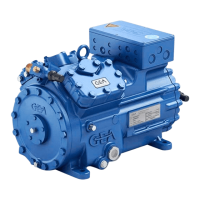24
D
GB
F
E
I
Ru
96178-06.2015-DGbFEIRu
6| Commissioning
6.1 Preparations for start-up
6.4 Evacuation
Firstevacuatethesystemandthenincludethe compressor in the evacuation process.
Relievethecompressorpressure.
Openthesuctionandpressurelineshut-offvalves.
Evacuatethesuctionanddischargepressuresidesusingthevacuumpump.
Attheendoftheevacuationprocess,thevacuumshouldbe<1.5mbarwhenthepumpisswitchedoff.
Repeatthisprocessasoftenasisrequired.
Thecompressorhasundergonetrialsinthefactoryandallfunctionshavebeentested.Thereare
thereforenospecialrunning-ininstructions.
Check the compressor for transport damage!
6.2 Pressure strength test
Thecompressorhasbeenfactory-testedforpressureresistance.Thefollowingmustbeobservedif
theentireplantissubjectedtoanadditionalpressurestrengthtest:
TesttherefrigerationcircuitaccordingtoEN378-2oracorrespondingsafetystandard.
6.3 Leak test
CarryouttheleaktestoftherefrigeratingsysteminaccordancewithEN378-2oracorresponding
safetystandardwithout including the compressor.
INFO
To protect the compressor against inadmissible operating conditions,
high pressure and low pressure pressostats are mandatory on the
installation side.
DANGER Risk of bursting!
The compressor must only be pressurised using nitrogen (N
2
).
Never pressurise with oxygen or other gases!
The maximum permissible overpressure of the compressor must
not be exceeded at any time during the testing process (see name
plate data)! Do not mix any refrigerant with the nitrogen as this
could cause the ignition limit to shift into the critical range.
DANGER Risk of bursting!
Do not mix any refrigerant with the nitrogen (N
2
) as this could
cause the ignition limit to shift into the critical range.
ATTENTION Do not start the compressor if it is under vacuum. Do not apply
any voltage - even for test purposes (must only be operated with
refrigerant).
Undervacuum,thespark-overandcreepagecurrentdistancesofthe
terminalboardconnectionboltsshorten;thiscanresultinwindingand
terminalboarddamage.

